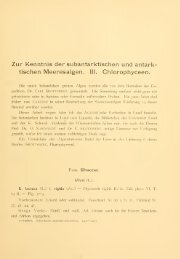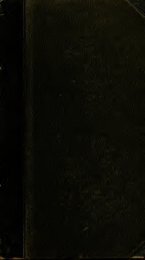Download PDF
Download PDF
Download PDF
You also want an ePaper? Increase the reach of your titles
YUMPU automatically turns print PDFs into web optimized ePapers that Google loves.
ZYGNEMA 15<br />
spores, and in parthenospores and aplanospores only two. In<br />
general the zygospores are compressed-globose or ovoid. There is<br />
an equatorial suture often marked by a slight ridge or keel<br />
(carinate), and in some species there are two lesser ridges on<br />
either side of the suture and parallel with it. These may not be<br />
visible in fresh fully distended spores but they become evident<br />
in dried or plasmolyzed specimens. Usually, the polar, or flatter,<br />
sides of the spores lie in the plane of the tubes, but there are<br />
6 species in which the plane of compression is at right angles to<br />
the axis of the tubes.<br />
The most abundant and generally distributed of the brown-<br />
spored isogamous species is Z. pectinatum, of the blue-spored<br />
isogamous species, Z. synadelphum. Of the anisogamous brown-<br />
spored species Z. stellintim is both abundant and widely distrib-<br />
uted; Z. peliosporum is its counterpart among the blue-spored<br />
species. As might be expected, all these species are highly variable<br />
in dimensions, and local varieties and forms are apparently common.<br />
It is not improbable that they have been the mutating forerunners<br />
of nearly related species found locally wherever the<br />
Zygnemas have been studied intensively.<br />
There is no good evidence that the taxonomic characteristics<br />
of species are changed materially by environmental conditions.<br />
There are alterations in chromatophores, accumulated foods, and<br />
thickness of walls due to exposure on soil, restricted photosyn-<br />
thesis, low temperatures, and mineral deficiencies. Reproductive<br />
capacity may be decreased or increased by external conditions.<br />
The mode of reproduction by zygospores or aplanospores, and the<br />
placement of the zygospores in the tubes, or in one of the gametangia,<br />
are the results of hereditary rather than environmental<br />
factors. In any one species the position of the spores, whether in<br />
the tubes or in the gametangia, does not change from season to<br />
season (see Fritsch and Rich, New Phytologist, 26 [1927]).<br />
There are several species in which the spores occur in either the<br />
gametangia or the tubes—even in the same pair of conjugating<br />
filaments.<br />
The identification of a species depends partly upon the dimensions<br />
of the vegetative cells. Vegetative cell diameters should be<br />
measured at the partition walls. Most important are the relative<br />
dimensions of the spores, their form, and the color and ornamen-<br />
tation of the several layers of the spore walls. Obviously only




